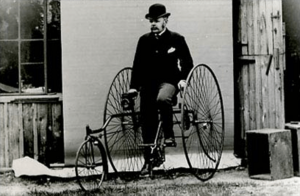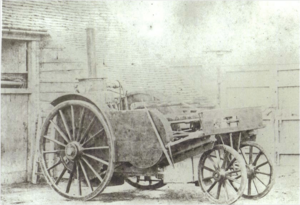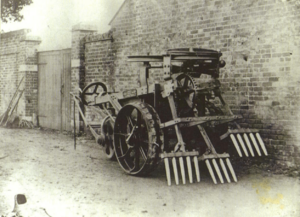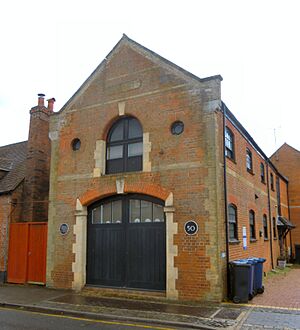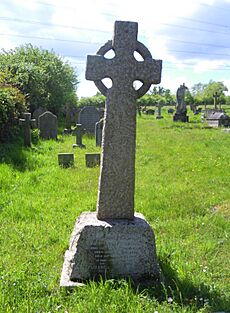John Henry Knight (inventor) facts for kids
Quick facts for kids
John Henry Knight
|
|
|---|---|
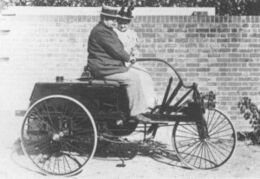
Knight driving "The first petroleum carriage for two people made in England"
|
|
| Born | 21 January 1847 Farnham, Surrey, England
|
| Died | 22 September 1917 (aged 70) Farnham, Surrey, England
|
| Occupation | Engineer, inventor, vehicle manufacturer |
| Years active | Victorian - 1890s |
| Known for | 1895 - built the first petroleum carriage for two people made in England |
John Henry Knight (born January 21, 1847 – died September 22, 1917) was a rich engineer, landowner, and inventor from Farnham, England. He is famous for building one of Britain's very first cars powered by petrol.
In 1895, with help from engineer George Parfitt, he created a three-wheeled car. When he drove it through Farnham, Surrey, he got into trouble with the law. This was because there were strict rules about vehicles at the time. People sometimes mistakenly think he was the first person fined for speeding in the UK. However, that was Walter Arnold in 1896.
John Henry Knight was a true pioneer. He invented many things, like a steam-powered machine for digging up hops (a plant used in beer) and a special radiator that saved heat. He also created a brick-laying machine, a grenade thrower, and even a speedometer.
He helped start the Automobile Association. He also worked to change old laws, like the "Red Flag Act," which made it hard for early cars to be used. Knight was also interested in early colour photography and wrote several helpful books.
Contents
A Young Inventor's Life
John Henry Knight was born in 1847. His father, John Knight, was a banker and brewer in Farnham. Sadly, his father passed away when John Henry was only nine years old. His mother was Mary Knight.
He grew up in a house called Weybourne House in Weybourne, Surrey, Farnham. Later, he moved to Barfield in Runfold, which is now a school.
When he was a child, he was very inspired by The Great Exhibition of 1851. This huge event showed off amazing new inventions. It made him want to become an engineer. He later owned his own engineering workshop in Farnham.
Britain's First Petrol Car
In 1895, John Henry Knight built one of the first petrol-powered cars in Britain. It had three wheels and could carry two people. Its top speed was about 8 miles per hour. This car was called the Trusty. It had a single-cylinder engine.
Many people believe it was the fourth car built in Britain. It might also have been the first petrol car ever driven on British roads.
Knight designed the car to get attention from the police. He wanted to show how unfair the old laws were for motor vehicles. He drove the Trusty for about 150 miles on public roads before the police stopped him.
On October 17, 1895, Knight's assistant, James Pullinger, was stopped by the police in Farnham. Knight arrived and was advised to admit that he didn't have a licence for the vehicle.
Knight and Pullinger were charged for using a vehicle without a licence. They had to go to court. They were each fined a small amount of money.
After this, Knight mostly drove his car on private farm roads. His actions helped lead to new laws that made it easier for cars to be used. These new laws replaced the old "Red Flag Act." This old law required a person to walk in front of a car with a red flag!
Knight's car was said to be "almost silent" when it ran. A few more of these cars were made in 1896. The Trusty car was later shown at a special display of early cars. Today, you can see the original car at the National Motor Museum.
John Henry Knight was also a founding member of the Automobile Club of Great Britain. This club held its very first meeting at his home.
Other Cool Inventions
Even though he's best known for his car, John Henry Knight was an inventor for many years. He designed machines powered by steam. He used them for farming and for early road travel.
Steam-Powered Vehicles
In 1868, he built an early steam-powered road vehicle. However, it wasn't very practical to use.
Hop Digging Machine
In 1872, Knight created a steam-powered machine for digging up hops. Hops are plants that grow on tall poles and are hard to dig around. Another inventor said that Knight was one of the first to use steam for digging. Knight designed many of these hop-digging machines.
More Inventions
His other inventions included:
- Knight's Thermosote Heat Saving Radiator, which helped save heat.
- A brick-laying machine. A wall built by this machine still stands at Barfield School! The machine couldn't build corners, though.
- A grenade thrower.
- A speedometer, which measures how fast something is going.
- Special wooden vehicle tyres for vehicles.
- Knight's 'dish lever' for tilting plates when carving meat.
Photography Pioneer
John Henry Knight loved photography. He was one of the first to experiment with colour photography. He took many pictures of Farnham and the countryside in the early 1900s.
Books He Wrote
He also wrote several books, including:
- Electric Light for Country Houses
- Reminiscences of a Country Town
- Notes on Motor Carriages with Hints for Purchasers and Users (Published in 1896, this book gave advice to people buying and using early cars).
- A Catechism of the Motor Car (This book had questions and answers about how cars work).
- Light Motor Cars and Voiturettes (A book from 1902 about smaller, lighter cars).
Remembering John Henry Knight
John Henry Knight passed away in September 1917. He is buried in the churchyard of St John's church in Hale, near Farnham.
There is a special black plaque on the wall of his old workshop in Farnham. It reminds everyone of his amazing achievement. The plaque says:
John Henry Knight's car, one of Britain's earliest petrol driven vehicles, was built here by George Parfitt at the Elliot Reliance Works. 1895
See also
- Frederick Bremer


